The research group's project proposes AI forensics as a new socio-technical framework for the analysis and critique of AI systems. This implies the design and development of new AI forensics tools for examining large AI datasets that cannot be analyzed manually, models (reverse-engineering the black-box effect), and applications (revealing their socio-historical context), making state-of-the-art results from explainable and interactive machine learning accessible to researchers in the humanities and beyond.
The resulting open-source AI forensics toolkit will be able to be used and shared with civic organizations, academia, and industry to investigate the social impact and consequences of AI systems in the field. The AI forensics toolkit will also support four sociotechnical investigations examining the facial recognition production pipeline, interpretability and accountability of AI in the humanitarian sector, bias-aware design methods for AI systems, and the role of visual AI models in science.
By closely integrating machine learning research and sociotechnical analysis, the project creates a new and comprehensive methodological framework to equip the humanities and social sciences with the necessary tools to study the impact of 21st century AI.
Website: kim.hfg-karlsruhe.de
About the project participants
Prof. Dr. Matteo Pasquinelli (PhD) is Professor of Media Philosophy at the Staatliche Hochschule für Gestaltung Karlsruhe, where he coordinates the Research Group for Artificial Intelligence and Media Philosophy KIM (kim-hfg-karlsruhe.de). His recent publications include the anthology "Alleys of Your Mind: Augmented Intelligence and Its Traumas" (Meson Press). His research focuses on the intersection of cognitive science, digital economy, and machine learning.
KIM HfG will coordinate a consortium of partners that also includes Prof. Dr. Leonardo Impett and Prof. Dr. Noura Al Moubayed (both Department of Computer Science, Durham University, UK), Prof. Dr. Claude Draude (Scientific Center for Information Technology Design, University of Kassel), and Prof. Dr. Fabian Offert (Department of Germanic and Slavic Studies, University of California - Santa Barbara, USA).
The Volkswagen Foundation's funding initiative "Artificial Intelligence - Its Impact on Tomorrow's Society", established in November 2017, also supports the KIM/HfG research project "AI Forensics: Accountability through Interpretability in Visual AI Systems" as one of seven project consortia with 1.4 million euros for a project duration of three years.
With its initiative, the Volkswagen Foundation aims to strengthen cross-disciplinary and cross-national research on the responsible further development of artificial intelligence (AI) systems.
"Against the backdrop of current and emerging developments taking place under the term "artificial intelligence," the aim is to enable new perspectives and insights with a view to shaping the future of society as well as technology, based on present-day diagnoses," according to the Volkswagen Foundation's official website.
The project "Adaptive Bilder. Technik und Ästhetik situativer Bildgebung" investigates the particular aesthetic, technical and operational aspects of adaptive imagery. It is part of the DFG priority program Das digitale Bild, which investigates the central role of the image in the complex process of the digitalization of knowledge from a multi-perspective point of view. In the process, a new theory and practice of computer-based image worlds will be developed in a Germany-wide network.
Website: www.digitalesbild.gwi.uni-muenchen.de
The digital image is becoming adaptive: In portable media and interactive applications, processor and sensor technology is increasingly being built in, which makes it possible to adapt images to their environment and thereby react to inputs and situations in real time. Image, body and space are interconnected and synchronized, with long-term consequences for human perception, actions and decisions. As so-called virtual or augmented reality applications, adaptive images have now reached the consumer sector and promise comprehensive usability in professional contexts as well, for example in industrial production. However, the expanded possibilities also entail new dependencies on technologies and on the aesthetic and operational specifications of those who design and provide these technologies. In fields such as medical practice, the comprehensive consequences of technological upgrading become clear. Surgeries are supported by automated real-time visualizations to such an extent that screen representations are taking the place of real bodies as the primary objects of reference. These are locked into comprehensive multimedia and multimodal visual apparatuses that are continuously extended through interfaces, mechatronic and logistic elements. Interfaces and algorithms anticipate decisions and constrain actions. Through application-based case studies, the project explores the permanent spatiotemporal interlocking of visualizations, objects, and actions, and identifies the associated challenges related to the perception, interpretation, and design of images that become action-guiding and even life-deciding. The study promises to make a fundamental contribution not only to image criticism, but also to the mechanisms of digital imagery.
Contact:
Matthias Bruhn ed.ehurslrak-gfh(ta)nhurbm
Kathrin Friedrich ed.nnob-inu(ta)hcirdeirf.k
Lydia Kähny .ed.ehurslrak-gfh(ta)ynheakl
Moritz Queisner ed.ehurslrak-gfh(ta)rensieuqm

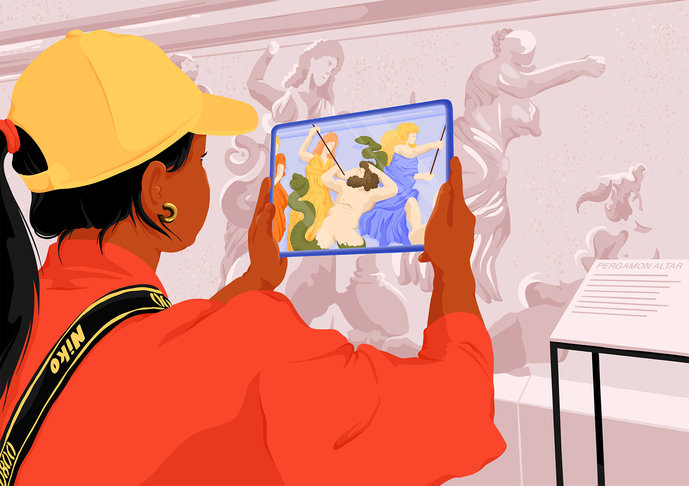
Illustration: Josephine Rais (CC BY-NC-ND)
The development project Open Resource Center (ORC) was started in October 2021. The goal is to establish a digital infrastructure at the Karlsruhe University of Arts and Design, which serves as an archive for final theses, student projects, courses, conferences, concerts, performances, exhibitions, etc., and can also be used as a data source for curatorial and publishing projects. The ORC brings together the areas of teaching, research, documentation, publication and archiving and thus takes into account the increasing merging of production and documentation processes.
The technical realization of the ORC's digital infrastructure is based on (Free) Open Source Software in order to guarantee both the long-term use of the infrastructure and free access to information. ORC’s core is a central database system that is largely organized bottom-up and provides all university members with a personal account. This system enables the autonomous archiving and sharing of data from teaching, research, and artistic development (share & archive), the testing of new digital and hybrid presentation formats (curate & perform), and the publication of digital content and formats within the university and beyond (publish & display). Various interfaces are being developed for the database to support data transfer to digital publication formats and platforms. Content with respective permissions can, for example, be integrated into scholarly publications, included in annual reports, displayed in graduate and annual exhibitions, or feed into showcase applications. With a view to the increasing intertwining of digital and physical space, the ORC will also work with HfG students and faculty to develop a physical portal for the digital archive.
The development and sustainable implementation of the ORC at the HfG will also be accompanied by workshops and seminars in which university members will learn techniques and practices of archiving and sharing digital content as well as how to use tools for research, data management and data visualization. A program of events is devoted to legal, economic, political, philosophical, artistic and design issues. The ORC informs about the program in a regular newsletter.
For the implementation of the project led by Dr. Barbara Kuon, a grant of 806,000 € could be obtained from the foundation "Innovation in University Teaching" for the period 2021 to 2024. More information about the funding decisions can be found on the homepage of the “Foundation for Innovation in Higher Education Teaching”.
For questions and suggestions, please contact project coordinator Dr. Katarina Schorb: ed.ehurslrak-gfh(ta)brohcsk

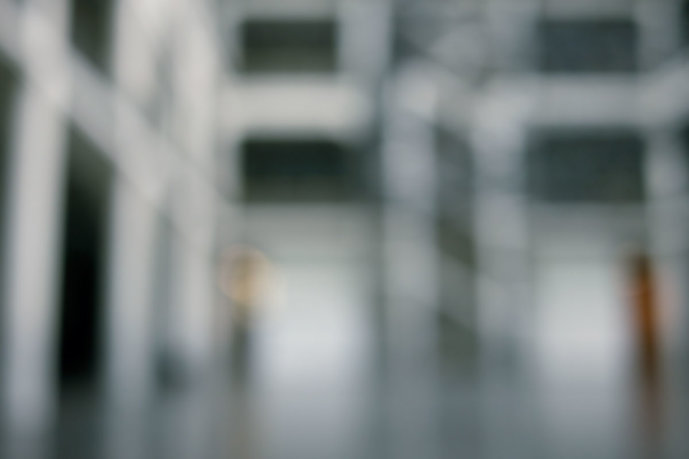
© Michail Rybakov
The Bio Design Lab is a hybrid and evolutive environment that exists in both the digital and physical space. Conceived as a platform for connection and collaboration with local partners and using local resources, the Lab hosts the presentation, education and transmission of knowledge. As students and experts are invited to work on bio-design related projects, visitors can explore and interact with the Lab’s production and lines of inquiry.
Projects within the Lab focus on the local region, its materials and possibilities, and actively aim to reshuffle and rethink modes of production in Karlsruhe and the south of Germany. To interact with these themes and related materials, both within the digital and physical space, the Lab invites local experts and visitors alike.
Within the Bio Design Lab, regional resources are collected by connecting with local partners; they are then distilled through the making of a know-how glossary and a material library, aiming to develop local materials. The knowledge around these resources is disseminated through virtual workshops and multimedia presentations of outstanding projects dealing with sustainable materials. Ultimately, traces of these activities will remain in a constantly growing network, both in the digital platform and in physical displays of existing and future objects.
The Lab works as an incubator and a model for collaboration and production that is in line with the current transformation of the Karlsruhe University of the Arts and Design.
Webseite of the Bio Design Lab: https://biodesignlab.de/en

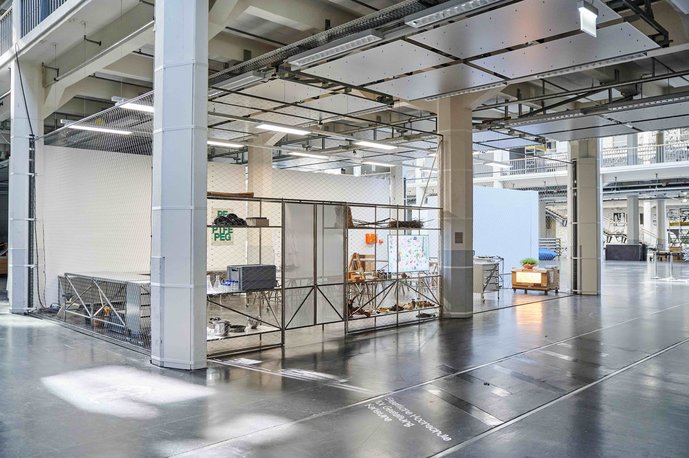
Photo: Arno Kohlem

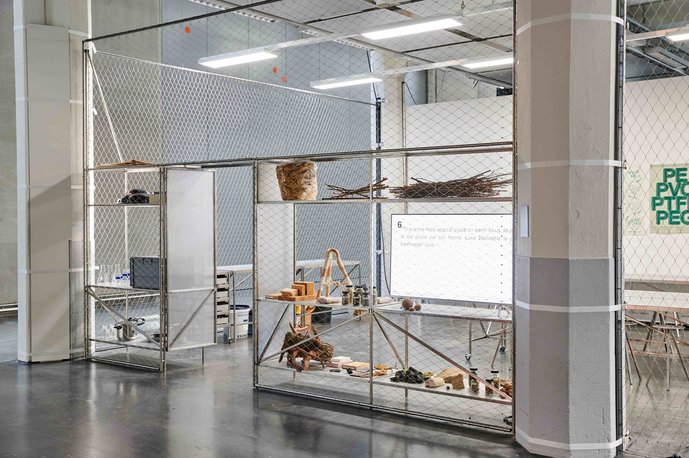
Photo: Arno Kohlem

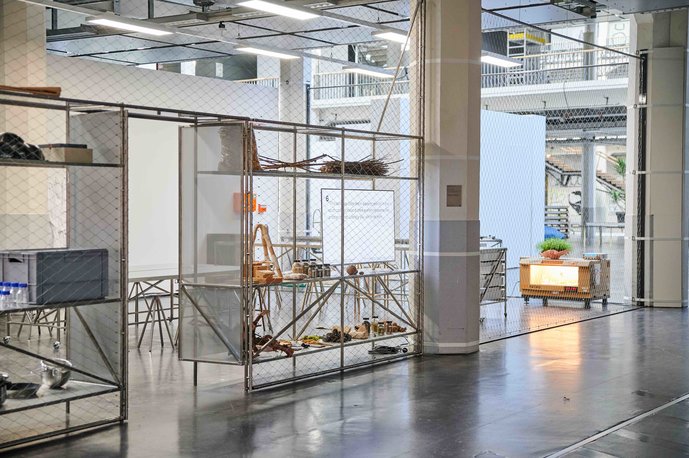
Photo: Arno Kohlem

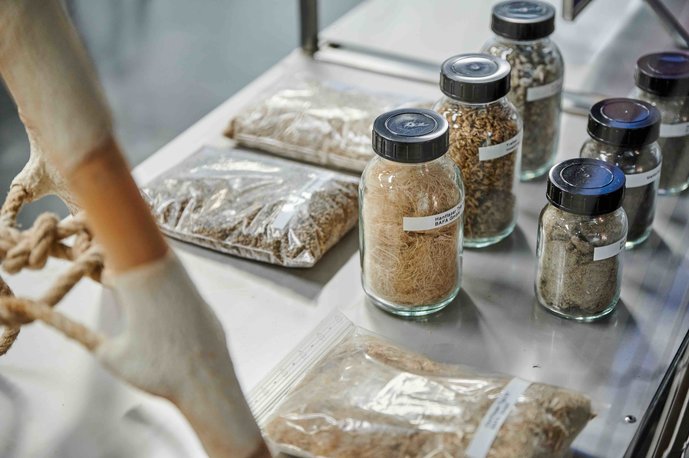
Photo: Arno Kohlem


Photo: Arno Kohlem
Together with the CCCB and the philosopher Amador Vega from Barcelona, HfG together with ZKM (Peter Weibel) designs and creates a large-scale exhibition on Ars Combinatoria of the middle-ages, which is seen as an important precursor for the development of algorithmic cultural tools. In this project, on the one hand the Arab and Islamic knowledge culture will be researched, which is already the subject of the “Allah’s Automata” project. On the other, the genealogies of algorithmic artifacts and contemporary art practice will be precisely reconstructed with combinatory machines.
The significant collection of film-maker and professor Werner Nekes including artifacts and technical systems for seeing and visualization built over the last decades, constructs a history of perception that stretches across the whole of European modernity. Integral to the project are the deliberate transgressions into Chinese, Indian or Arabic image and representation culture. Concurrently, the planned exhibition at ZKM Karlsruhe aims to construct a permanent research platform for the genealogy of seeing- and image-machinery in Karlsruhe.
The conference (February 16–18, 2017) marks 25 years since Karlsruhe University of Art and Design was founded. As with the founding of the university, the most important gesture is not retrospective, but prospective. We ask questions and set challenges for ourselves toward a possible future of art and design research and education as well as future of the university and its connections to ZKM | Center for Art and Media Karlsruhe. The term potential spaces, coined by Donald Winnicott, seems appropriate in order to gauge as radically as possible with free spaces of the future while going beyond exclusively Western perspectives. It is neither our interest to establish a new institutional context, nor to rigidly define any program. It is about thinking through the possibilities that art and design will bring to people all across the world in the decades to come, and how we can teach, study and research them. A re-thinking of the dispositif of art academies should find as much space here as thinking about the possibilities of open, networked collaborations.
On the evening of February 16, 2017, the conference opens in the “Cube” of ZKM, which will be accompanied by artistic interventions. In the following two days, presentations and discussions will form the conference’s core elements. The analysis and its results will be published as an English reader.
A series of sub-projects are summarized under this title, in which advanced techniques in image and visualization such as virtual reality (VR) or three-dimensional illusion techniques such as cinematographic stereoscopy, take centre stage. Projects such as “Down the Rabbit Hole” supported by MfG Baden-Württemberg already exist, or like the project on “Future Design” they are currently undergoing application in the Creative Culture Program of the European Union.
Together with ZKM’s exhibition and research platform, the HfG plans a worldwide unique post-graduate program, where design and artistic projects are generated and taught in close proximity with research in humanities and sciences. The course will take place in English and is concluded with a hybrid international PhD.
In August 2016, HfG Karlsruhe and ZKM collaboratively brought the research and development program “Archivists in Residence” into existence. The four-month residency on offer two times a year is suitable for young researchers working artistically and/or theoretically with archives and archival practices in a broad sense of the word. Objects of study are cultural artifacts that exist in the ephemera of those technological realities at risk of falling victim to cultural oblivion today. Archivists of the present and the future who face up to these inherent challenges must be persons with hybrid qualifications. They must be well versed in information technology and information science, as well as in the archeology of art and media and critical archivology. In order to effectively support such a field of research, Karlsruhe University of Arts and Design and ZKM pool their resources together and offer an adequate research environment for the residency.
IMAGIT is a cultural project of international cooperation between Karlsruhe University of Art and Design, brainz (Prague), HANGAR.ORG (Barcelona) and The Hungarian University of Fine Arts (Budapest), supported by the Creative Europe Programm of the European Commission. The project is dedicated to explore creative digital communication and brings together artists, designers, researchers and technology experts. Special interests are addressed to the topics gamification, user interaction, non-verbal communication as well as reflexive and artistic approaches of data and sound interpretation.
Project website: www.imagit.net